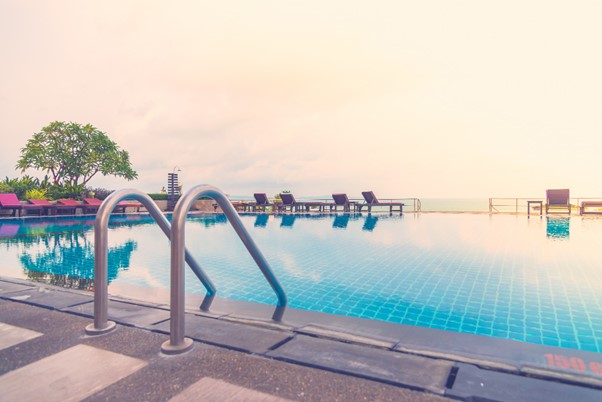The Ultimate Guide to Choosing the Perfect Pool Pavers

Introduction-
A stunning swimming pool instantly elevates the aesthetic appeal and value of a property. However, the space surrounding the pool is just as important. One critical element of pool design is the choice of pool pavers. Picking the perfect paving material and design ensures that the pool and its surroundings look spectacular and serve as an attractive addition to your outdoor space. This article serves as a comprehensive guide to selecting, installing, and maintaining the perfect pool pavers.
- Why are Pool Pavers Important?
Pool pavers play a dual role: function and style. They create a more comfortable surface to walk on while reducing the risk of slips and falls due to wet conditions. Additionally, pool pavers add visual interest and elegance to the pool surroundings. When chosen wisely, pool pavers can enhance the overall design of the swimming pool, ensuring that the pool area is a beautiful extension of your home’s outdoor living space.
- Types of Pool Paver Materials-
There is a wide variety of paving materials to choose from for pool surrounds. Some of the most popular materials include:
– Concrete Pavers: These are available in numerous designs, colors, and finishes. They are easy to install, low maintenance, and cost-effective.
– Brick Pavers: Offering a classic and timeless look, brick pavers are durable and slip-resistant. They are also versatile in terms of color and pattern choices.
– Natural Stone Pavers: With a luxurious and elegant appearance, natural stone pavers are available in various textures and colors. Common types of natural stone pavers include granite, travertine, bluestone, and slate.
– Ceramic & Porcelain Tiles: Highly customizable in design and color, ceramic and porcelain tiles can mimic the look of natural stone, wood, or concrete. They are also low maintenance and offer excellent slip resistance.
- Factors to Consider When Choosing Pool Pavers-
Price-
The cost of pool pavers varies greatly depending on the material, design, size, and quantity required. It’s essential to consider both the purchase and installation costs while selecting. Budget-conscious buyers might opt for concrete or brick pavers, while those with a larger budget might lean towards natural stone pavers.
Durability-
Pool pavers should be durable and able to withstand the harsh pool environment, including exposure to water, chemicals, and direct sunlight. Consider materials that are resistant to cracking, chipping, and staining to ensure longevity.
Slip Resistance-
Slip resistance is critical in wet and slippery conditions around a pool. Materials with textured surfaces, such as natural stone and concrete pavers with a textured finish, offer better slip resistance compared to smooth tiles or pavers.
Design-
Pool pavers come in various shapes, sizes, colors, and patterns. Consider selecting a design that complements the pool’s overall style and ambiance, as well as the surrounding landscape and architecture.
Appearance-
The visual appeal of pool pavers is crucial in creating an inviting and cohesive pool environment. Choose colors and patterns that blend seamlessly with the natural surroundings or contrast for a striking effect.
- Popular Design Ideas for Pool Pavers-
– Classic brick herringbone pattern
– Modern stacked bond pattern using concrete pavers
– Rustic flagstone with irregular shapes and edges
– Sleek and contemporary large-format ceramic tiles
– Mixed materials, such as combining wood decking with natural stone pavers
- How to Install Pool Pavers?
Installing pool pavers demands careful planning, site preparation, and the right tools and materials. Key steps in the installation process include:
– Measure and mark the area for the new pool pavers
– Excavate and level the ground
– Install stable edging or retaining walls
– Spread and compact the base material
– Add a layer of bedding sand
– Lay the pavers according to the chosen pattern, maintaining consistent spacing
– Install additional edge restraints as needed
– Fill the joints with sand, and compact the surface
– Clean and seal the finished pool pavers
It’s essential to consider hiring a professional installer to ensure paver installation is accurate, efficient, and durable.
- Maintenance Tips for Pool Pavers-
– Sweep or gently hose down pool pavers regularly to remove dirt and debris
– Use a commercial pool cleaner or mild dishwashing soap to treat stains and algae
– Address cracks, chips, or loose pavers promptly to avoid further damage
– Regularly clean the pool water to minimize the impact of chemicals on paver surfaces
– Seal pavers, especially natural stones, according to the manufacturer’s recommendations
Conclusion-
Pool pavers can significantly enhance the safety, function, and beauty of a swimming pool area. By considering factors such as price, durability, slip resistance, design, and appearance, homeowners can make an informed decision on the suitable selection for their pool. Ultimately, the right choice in pool pavers will contribute to a stunning and enjoyable outdoor oasis for years to come.
-
-
-
-
/ 0 Comments